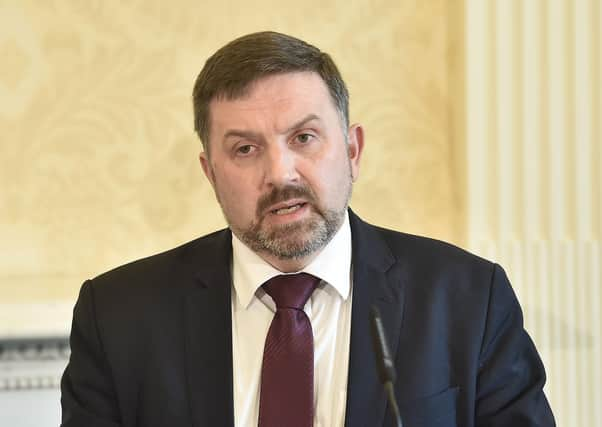NI Covid-19 reasonable worst case: 15,000 dead and hospitals overwhelmed in surge ‘of Biblical proportions’


In a sobering urgent written statement to the Assembly this afternoon, Robin Swann set out figures which point to a potential death toll more than four times greater than the deaths throughout 30 years of the Troubles.
Just hours after Northern Ireland’s first death from Covid-19 was announced, a sombre Mr Swann this evening told a press conference in Stormont Castle: “The scale of the surge coming towards us is of Biblical proportions”.
Advertisement
Hide AdAdvertisement
Hide AdMr Swann said that the number of deaths could be significantly cut if the public follows radical advice from the government to stay at home if possible and to wash hands regularly.
Speaking to the public, he said: “Your actions today will affect the number of deaths in Northern Ireland; don’t be a spreader.”
Mr Swann said: “Our health service will fast become unrecognisable. Changes that would have seemed unthinkable weeks ago will become the new norm. Decisions that would previously have taken months or even years will be taken in hours.”
The minister said that the planning assumptions available to his department pointed out that in a reasonable worst case scenario “if we fail as a community to take action to slow down the transmission of the virus in line with the recommended public health guidance” then up to 80% of the Northern Ireland population will be infected – about 1.5 million people.
Advertisement
Hide AdAdvertisement
Hide AdHe said that his department’s planning assumptions indicate that 8% of infected people will require hospitalisation – about 121,000 in that scenario where 80% of the population is infected – with about 0.7%, some 10,600 people, requiring critical care.
The minister said that the assumed mortality rate would be 1% – meaning that about 15,200 people would die if 80% of the population was infected.
Alluding to the fact that the elderly or those with other health problems are particularly vulnerable, Mr Swann stressed that the figures “will vary highly depending on age and other health factors”.
Speaking at a press conference tonight, Mr Swann referred to a possible death figure of 9,000 – based on more of the public abiding by advice, leading to 50% of the population contracting the virus.
Advertisement
Hide AdAdvertisement
Hide AdThe minister emphasised that if social distancing – isolating at home or keeping distance from other people when in public – and other measures are implemented by the population, that could reduce the peak by some 50% and reduce deaths by up to a third.
Mr Swann said that up to half of cases may occur in a period of three weeks centred around the peak – a flood of cases which would overwhelm any health system. But Northern Ireland’s health system is going into the pandemic in a damaged state, with the Royal College of Surgeons warning four months ago that it was “at the point of collapse”.
Mr Swann said bluntly: “Simply put, no health service in the world is equipped to cope with the volume of cases that we will see if this scenario comes to pass.
“However, we have the ability to reduce the potential impact of Covid-19 by protecting our families, friends, and all of the vulnerable people across Northern Ireland, by reducing social contact as much as possible and, if any of us have symptoms, to stay at home.”
Advertisement
Hide AdAdvertisement
Hide AdIn the face of such vast numbers needing hospitalised, the NHS in Northern Ireland still has only 280 beds on designated wards to treat Covid-19 but the Department of Health said that work was underway to convert medical specialism wards into Covid-19 wards, something possible because all non-essential hospital business will be stopping.
Northern Ireland has 88 critical care beds, of which 56 are intensive care units for those needing a ventilator to breathe.
However, even those figures depend on all medical staff being well – yet Mr Swann said that up to 21% of medics could be absent, meaning that other medical staff will have to be redeployed.
Mr Swann also set out “more radical ways to enhance our workforce capacity”, authorising the redeployment to clinical care of up to 880 third year nursing and midwifery students and 236 final year medical students from Queen’s University.
Advertisement
Hide AdAdvertisement
Hide AdIn another sign of the gravity of the situation, health trusts are exploring using third and fourth year medical students in temporary medical support technician roles.
Mr Swann said that once the pandemic has passed, some areas of the health service will be “irrevocably changed”.
Addressing health staff, the minister said: “The words ‘thank you’ seem woefully inadequate in the circumstances but they still need to be said on behalf of everyone across our society.”
Mr Swann stressed that for the majority of people the virus “will result in a mild illness from which they will quickly recover” but that those people could be spreading death to others.
Advertisement
Hide AdAdvertisement
Hide AdThe minister accepted that “these measures come at a cost”, that they “will be difficult for people to stick to” and “will have significant social and economic impacts”.
But he said that heeding the advice to avoid other people and wash hands regularly, lives will be saved.
The pandemic is “the biggest public health emergency in our lifetime”, he said, adding that the number of Covid-19 tests per day would be increased from 200 to 800 – at least partially addressing a criticism of the UK approach which has seen much less testing than in many other countries battling the virus.
Mr Swann said that he was mindful of elderly people who may be fearful of what is happening and he said that the department would work to allow them to stay in their own homes if they can and would be writing to the 40,000 people at highest risk over coming days.